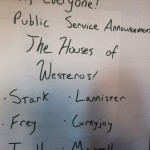When my mother read yesterday’s post on peer mediation and restorative justice, she was surprised I had left out a story from my own childhood. In fourth grade, I was a peer mediator, and, one day, after school, our doorbell rang, and my mom found a classmate who had looked up where I lived and walked over to ask if I would mediate an out-of-school fight.
According to my mom, I walked outside and started going through the mediation script (“Do you agree to listen to each other” etc) but one of the conditions was too onerous for them to sign on for, and the other kids scarpered.
I had no memory of this incident, but I do remember mediating a fight that started during a floor hockey game and being afraid I was going to get hit with one of the hockey sticks.
I’m primarily ignoring the World Cup, but, due to an amusing post by Math With Bad Drawings about the opposite versions of sports, I discovered strange saga of the Barbados-Grenada game of the of 1994 Caribbean Cup. I’m just going to reproduce Wikipedia’s description of the incident here:
Grenada went into the match with a superior goal difference, meaning that Barbados needed to win by two goals to progress to the finals. The trouble was caused by two things. First, unlike most group stages in football competitions, the organizers had deemed that all games must have a winner. All games drawn over 90 minutes would go to sudden death extra time. Secondly and most importantly, there was an unusual rule which stated that in the event of a game going to sudden death extra time the goal would count double, meaning that the winner would be awarded a two goal victory.
Barbados was leading 2-0 until the 83rd minute, when Grenada scored, making it 2-1. Approaching the dying moments, the Barbadians realized they had little chance of scoring past Grenada’s mass defense in the time available, so they deliberately scored an own goal to tie the game at 2-2. This would send the game into extra time and give them another half hour to break down the defense. The Grenadians realized what was happening and attempted to score an own goal as well, which would put Barbados back in front by one goal and would eliminate Barbados from the competition.
However, the Barbados players started defending their opposition’s goal to prevent them from doing this, and during the game’s last five minutes, the fans were treated to the incredible sight of Grenada trying to score in either goal while Barbados defended both ends of the pitch. Barbados successfully held off Grenada for the final five minutes, sending the game into extra time. In extra time, Barbados notched the game-winner, and, according to the rules, was awarded a 4-2 victory, which put them through to the next round.
And while we’re talking about bizarre distortions caused by misguided rules, how can I not mention a fun Mercator map tool?
Drew Roos has built a tool that lets you shift the pole of a Mercator projection, so you can customize which parts of the world get warped as badly as Greenland and Antartica. (h/t Nathan Yau). Here’s what happens when you set New York City at the pole:
And I would never give you a map link without this clip:
https://www.youtube.com/watch?v=n8zBC2dvERMI didn’t get to watch the Tony Awards live this week, but, having mostly caught up on the performances online, I’m pretty sure I can tell you that this number from A Gentleman’s Guide to Love and Murder was the best of the night. In fact, it was probably best of the night before the first note was sung, and you’ll shortly see why:
https://www.youtube.com/watch?v=BV356ZKDn34Les Mis got a performance slot at the Tonys but, in lieu of that video (which was fun, but no better than the Les Mis in Concert clips you’ve probably seen), let me share the exchange I found on MBlume’s tumblr instead:
someone literally named an asteroid after jean valjean are you fucking kidding me
now we know why javert spends so much time looking at the stars
#THERE.#OUT IN THE DARKNESS.#A FUGITIVE RUNNING.#FALLEN FROM GOD
Shout out to the dude from ‘70’s that was a part of the Les Mis fandom that decided to name it that because of the fact it was asteroid # 24601
Christian H, a delightful commenter here, has started a blog keeping track of various delightful thing, and Hnefatafl is my favorite thing he’s shared so far:
Gameplay is asymmetric, with one side consisting of 12 soldiers and a king, stationed in the center of the 11×11 board. The other side consists of 24 soldiers positioned in groups of six around the edge. All pieces move as rooks in chess (in straight lines only, no distance limit) and pieces are captured by sandwiching an opponent’s piece between two of yours. The king’s objective is to escape off the edge of the board before being captured by complete encirclement, and king’s side is generally considered easier to win.
The way the game manages its asymmetry was interesting enough, but it was even better to find out that this is the game that inspired Thud!
And finally, when I was reading a feature on arsenic and fashion, I found out about one factor that shaped historical fashion design that I had never considered.
Mania for arsenic green (also used in artificial flowers, wallpaper, paint, even medicine for morning sickness) offers the perfect example. Its popularity was abetted by ready supply as a mining by-product (William Morris’s family owned the biggest arsenic mine in England), as well as by the arrival of the electric light bulb, which shifted colour preferences. “It retained a luminous quality in daylight or evening,” says Semmelhack, who notes that it wasn’t until the light bulb that diamonds became important in fashion “because they really sparkled.”
For more Quick Takes, visit Conversion Diary!














